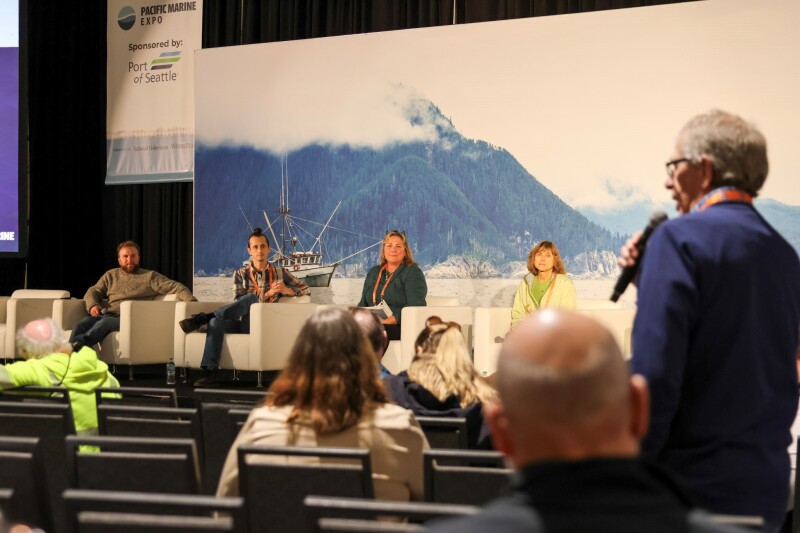In a time when the commercial fishing community faces challenges on many fronts, ensuring seafood becomes an integral part of national food systems requires more than hard work on the water.
As political opportunities evolve, the seafood sector must strengthen its advocacy efforts to gain the support it needs from the halls of Washington, D.C., to local communities. Noah Oppenheim, principal at Homarus Strategies and coordinator of the Fishing Communities Coalition, kicked off a recent panel at the Pacific Marine Expo by emphasizing the need for increased advocacy and action. "We need to re-establish seafood systems," Oppenheim said. "We need to ensure that we are getting the support we need from the U.S. Department of Agriculture to support seafood and commercial fisheries as members of our domestic food system."
One of the most pressing issues for the seafood industry is the lack of attention given to aquatic and marine food systems despite their critical role in global and national food security. According to Josh Stoll, a faculty member at the University of Maine’s School of Marine Sciences and the founder of the Local Catch Network, this issue is starkly apparent when looking at federal funding. "In the U.S. Department of Agriculture's budget, seafood-related grants make up only 0.5 percent of the total," Stoll pointed out. "Of that, 80 percent goes to aquaculture, leaving wild-capture fisheries with a tiny portion of that 0.5 percent."
Stoll’s research, which analyzed USDA grants across the past six years, revealed just how underfunded the seafood sector is in comparison to the terrestrial agriculture sector. "In any given year, the USDA distributes around $31 billion in grants, but only a fraction of that supports seafood," he noted. "That’s where the gap lies, and we need to address it if we’re serious about integrating seafood into our national policies."
While the gap in funding is clear, Stoll, alongside his colleagues, is optimistic about the potential to expand the reach of seafood in the national food system. “We have a lot of work to do,” he said, “but there are opportunities to build power and create lasting change.”
Andrea Tomlinson, executive director of the New England Young Fishermen's Alliance, exemplified one opportunity, who shared her experience navigating USDA grants to support wild-capture fisheries. "We are part of that 20 percent of the 0.5 percent of USDA grant funding that goes toward wild-caught fisheries," Tomlinson shared. She also encouraged others in the fishing community to consider the USDA’s potential. "If you’re looking for funding for your business, I encourage you to look into USDA grants. Money is available, and they want to help you get it."
Tomlinson recalled how, with the guidance of Josh Stoll and his team at the Local Catch Network, she was able to secure USDA funding for her organization. "We worked with USDA case managers who were very clear, ‘We have the money. Let us teach you how to get it,’” she explained. "The key is to translate your fisheries language into USDA language."
For many, applying for grants can feel daunting, but Tomlinson has learned to clarify the process. "It’s not as difficult as it seems," she said. What you need is to make your project fit into the specific objectives of the grant. If you can do that, you’ll increase your chances of success."
Linda Behnken, executive director of the Alaska Longline Fishermen's Association, has firsthand experience applying for USDA grants to support Alaskan fisheries. "With USDA's help, we’ve been able to support projects like Alaskans Own, a community-supported fishery that connects consumers with sustainably caught seafood."
Behnken's work exemplifies how grants can strengthen local seafood economies. Her team used funding to tackle food insecurity in Alaska, supplying seafood to communities in need during the COVID-19 pandemic. "With the support of this grant, we’ve provided 650,000 seafood meals across Alaska," Behnken said. We’re building a system that keeps Alaska seafood in Alaska and addresses the growing demand for local food."
However, Behnken noted this work is far from over. "The next step is to secure further funding to implement the infrastructure needed to sustain this work," she explained. "Grants like these have helped us make great strides, but it will take more to create a lasting, sustainable system."
In all of these stories shared during the panel, a common theme emerged: with strong advocacy, collaboration, and persistence, the seafood community can expand its role within the larger food system. Oppenheim’s call to action resonated, “We need to build power and re-establish seafood systems that support fishermen, communities, and consumers alike.”
As this panel showed, it’s time to integrate seafood into national food systems. Through strategic advocacy and leveraging resources like USDA grants, the future of commercial fishing can be brighter and more integrated than ever before.







